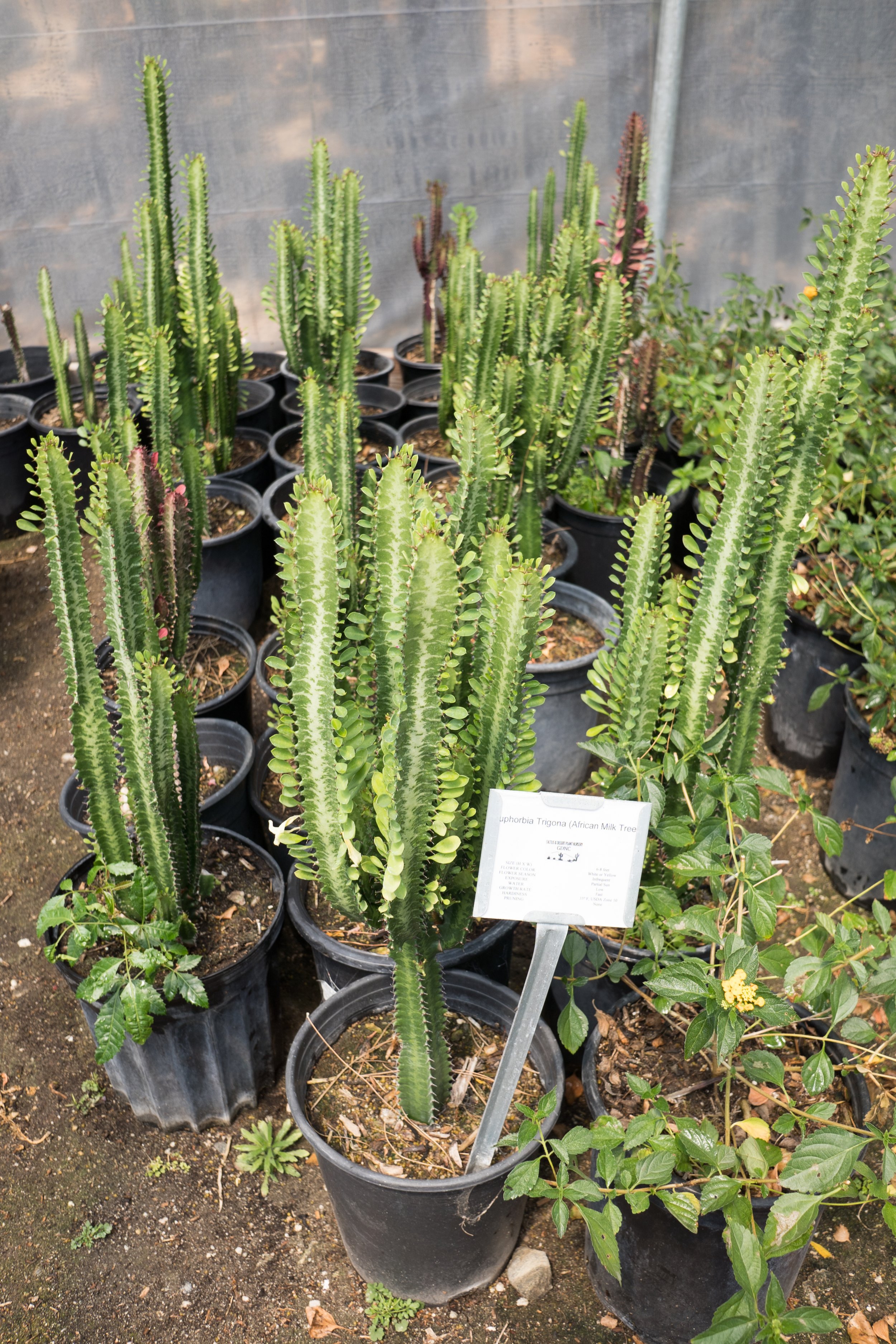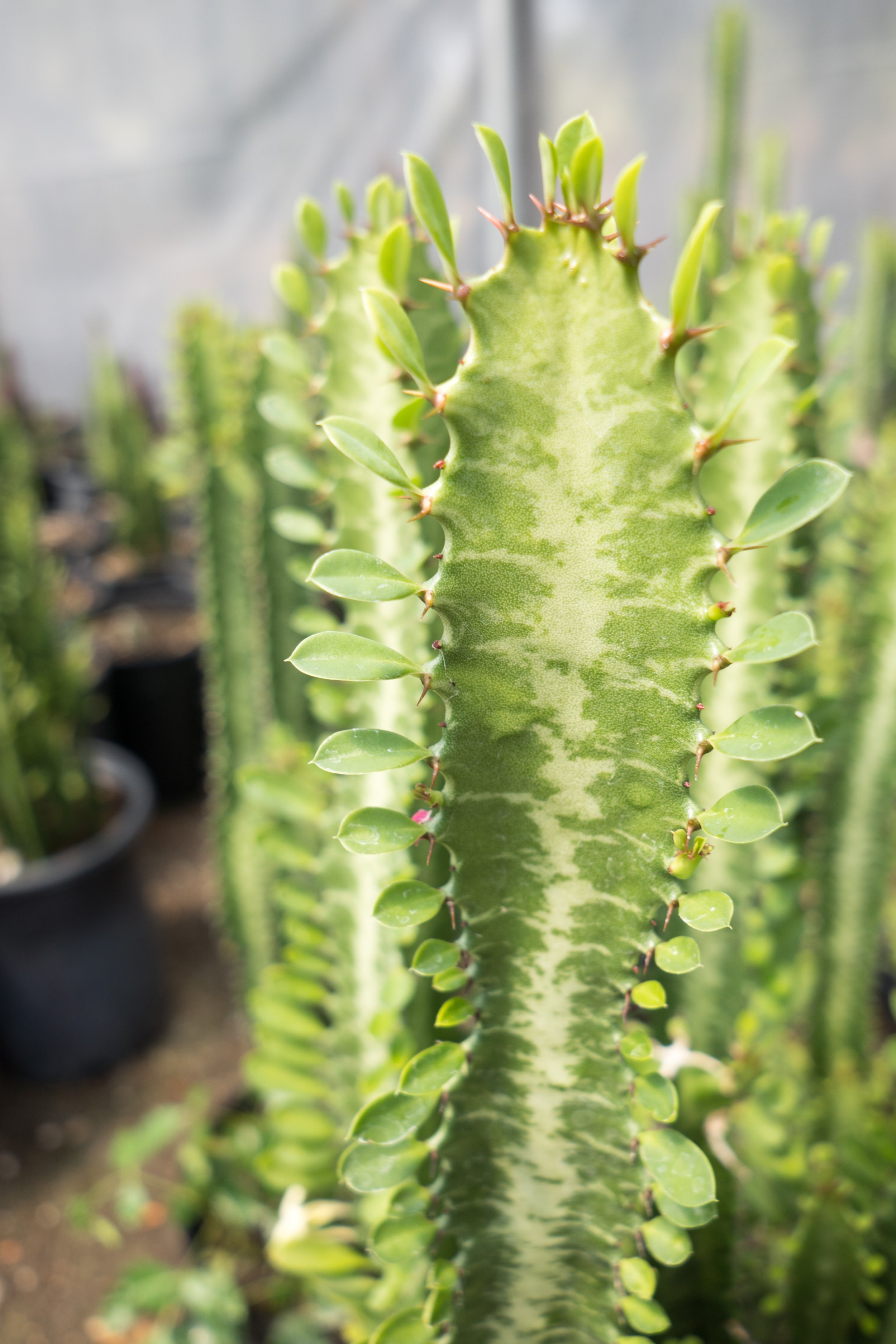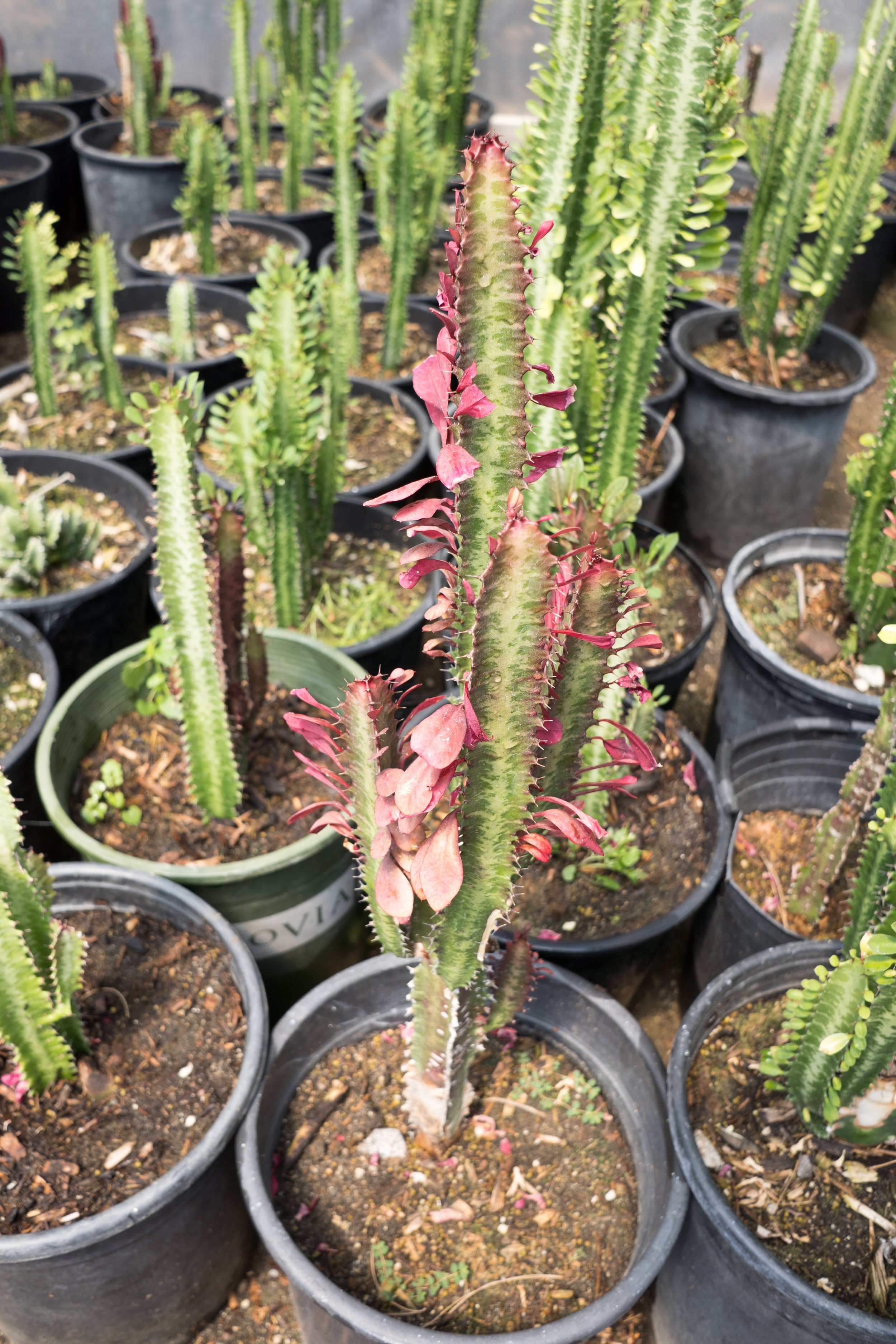African Milk Tree
The African milk tree is one of those plants that once you’ve identified it, you’ll remember forever.
It has a highly unusual shape, with its small leaves that grow from the sides of candelabra-like stems, which will certainly capture your attention.
Perhaps the beautiful shades of dark green (and magenta for the ‘Rubra’ variety), and chic, upright growing pattern are the reasons it has become a popular plant among the fashionable, young crowd.
Botanical name: Euphorbia trigona
Other names: African milk bush, Cathedral cactus, Euphorbia hermentiana, Friendship cactus
Various African milk trees for sale at the nursery
TABLE OF CONTENTS
African Milk Tree Appearance
Up close look at African Milk Tree
Very distinct shape. Stems are formed of three sides (hence the name trigona), have unusual, small leaves shaped like teardrops growing from the sides, and many small, sharp spines.
Although commonly seen as a small to medium-sized container plant with a handful of stems, eventually, numerous stems will grow into a dense thicket. This growing pattern is perhaps why it's called a tree, although it's a succulent. A main woody "tree trunk" will develop as it matures. Stems have a vertically growing habit.
African milk trees can grow to 10 feet tall given favorable conditions. Indoors, it often grows to 6 feet or so.
The stems and branches are dark green which becomes brighter with more light. Euphorbia trigona 'Rubra,' also named Euphorbia trigona 'Royal Red,' is a variety that features both the green and magenta-purple hues. Beautiful, vibrant color on both varieties.
Leaves drop during the dormant season and regrow at the start of the growing season. In conditions in which the light intensity and temperature do not fluctuate much, leaves may stay on for longer than a year.
African Milk Tree Landscaping Tips
Euphorbia trigona is becoming a trendy houseplant, especially among the younger demographic that covets plants with unique shapes and colors. Quite a photogenic and architectural plant!
Frequently grown in pots indoors, and used as a statement piece. Requires bright light indoors.
If you live in a warm and dry region, such as Palm Springs, you can grow the euphorbia outdoors. Provides a nice vibrant color to the garden year-round.
Very shallow roots compared to the height of stems. To prevent it from falling over, plant it deep in the soil. If planting in a container, we recommend using pots made of heavy material such as terracotta rather than light material such as plastic.
As with all euphorbias, Euphorbia trigona has white latex beneath the outer layer. Careful with handling the plant since the sap is very toxic.
Some people use the African milk tree as a hedge since it grows densely and has spines. To keep the size in check, keep plants in containers.
African Milk Tree Origin
Parts of Africa that experience warm and dry weather such as Angola and Gabon
African Milk Tree Care
Caring for an African milk tree is easy, and is similar to caring for the typical cactus. The main issues are overwatering.
Soil: Loose, well-draining soil that is moderately fertile.
Temperature: Can withstand temperatures down to frost (= 32 degrees) for a short period of time.
Water: Occasional, deep watering. Allow the soil to completely dry out between waterings. Either use a moisture meter or stick your finger through the soil to gauge the moisture level. It’s better to err on the side of underwatering than overwatering.
Sun: Full sun in temperate regions. Partial shade in the Palm Springs area.
Euphorbia trigona 'Rubra,' also named Euphorbia trigona 'Royal Red’ for sale at the nursery
African Milk Tree Problems
Pests: African milk tree has minimal pests such as mealybugs.
To remove mealybugs, use insecticidal soap or apply rubbing alcohol directly to the area of the infestation using a cotton swab.
Whenever using any kind of pesticide, be aware that it can damage the plant if the temperatures are in the 80s or above.
Signs of overwatering: Drooping, squishy texture, yellowing leaves, dropping leaves
Signs of too little water: Shriveling, drying skin, dropping leaves
Signs of too much sun: Burning, scarring, fading color, browning
Signs of too little sun: Etiolation, discoloring
African Milk Tree Propagation
Propagating the African milk tree is similar to propagating a typical cactus. Carefully cut off a stem with gloves and tools since it will leak poisonous, white sap.
Allow stem cutting to dry out for several days to prevent rot. Plant in soil.
FAQ
How much does an African milk tree cost?
At our nursery, an African milk tree costs $45 for a 5-gallon container and $150 for a 15-gallon container.
Prices are subject to change. Please contact us for the most up-to-date information on pricing. We may have larger sizes available. We provide installation services locally at a separate cost.
How fast does the African milk tree grow?
African milk tree grows moderately fast, at about a foot a year.
How big does the African milk tree get?
African milk trees can grow to 10 feet tall given favorable conditions. Indoors, it often grows to 6 feet or so.
Does the African milk tree have spines?
Yes, the African milk tree has many spines that grow from the sides of the stems.
Is the African milk tree poisonous?
Yes, the African milk tree has white milky sap, which is toxic.
Summary
| SIZE (H X W) | 6-10 feet |
|---|---|
| FLOWER COLOR | White or Yellow |
| FLOWER SEASON | Infrequent |
| EXPOSURE | Partial Sun |
| WATER | Low |
| GROWTH RATE | Fast |
| HARDINESS | 35º F, USDA Zone 10 |
| PRUNING | None |


